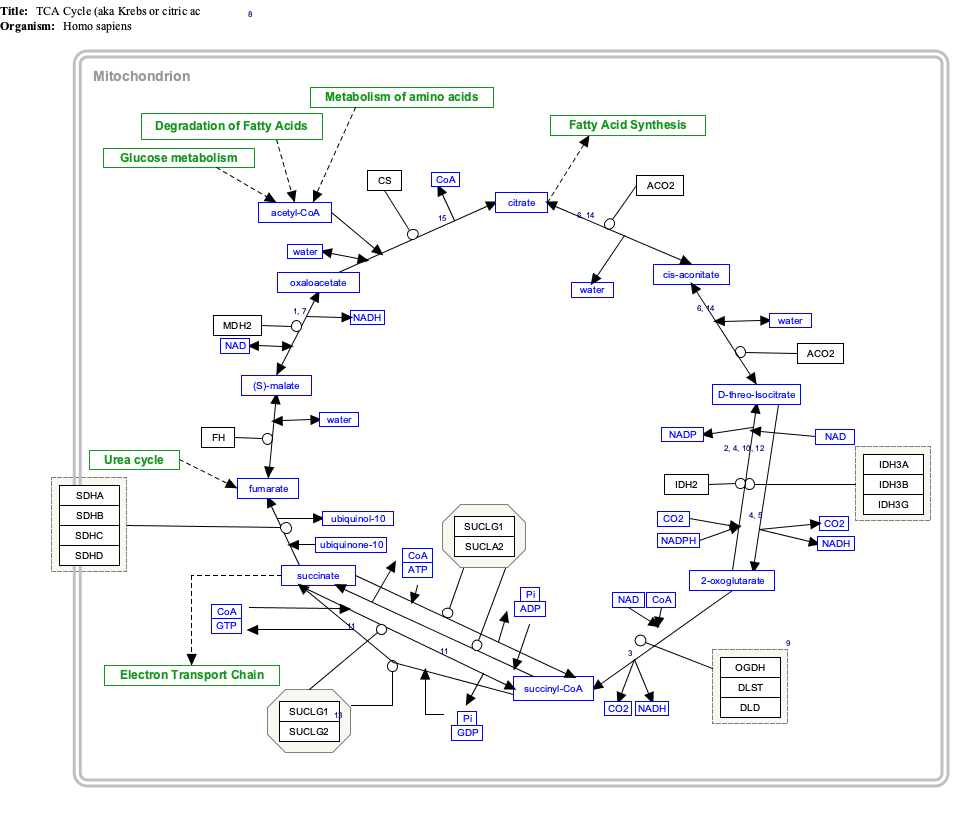Updating {{chembox}} (no changed fields - added verified revid - updated 'UNII_Ref') per Chem/Drugbox validation (report errors or [[user talk:CheMoBot|bu |
No edit summary |
||
| Line 35: | Line 35: | ||
}} |
}} |
||
}} |
}} |
||
'''Acetyl coenzyme A''' or '''acetyl-CoA''' is an important molecule in [[metabolism]], used in many biochemical |
'''Acetyl coenzyme A''' or '''acetyl-CoA''' is an important molecule in [[metabolism]], used in many [[biochemical reaction]]s. Its main function is to convey the [[carbon]] [[atom]]s within the [[acetyl]] group to the [[citric acid cycle]] to be [[oxidation|oxidized]] for energy production. In chemical structure, acetyl-CoA is the [[thioester]] between [[coenzyme A]] (a [[thiol]]) and [[acetic acid]] (an [[acyl]] group carrier). Acetyl-CoA is produced during the second step of aerobic [[cellular respiration]], [[pyruvate decarboxylation]], which occurs in the [[Matrix (biology)|matrix]] of the [[mitochondria]]. Acetyl-CoA then enters the citric acid cycle. |
||
Acetyl-CoA is also an important component in the biogenic synthesis of the neurotransmitter [[acetylcholine]]. [[Choline]], in combination with acetyl-CoA, is catalyzed by the enzyme [[choline acetyltransferase]] to produce acetylcholine and a [[coenzyme a]] byproduct. |
Acetyl-CoA is also an important component in the biogenic synthesis of the neurotransmitter [[acetylcholine]]. [[Choline]], in combination with acetyl-CoA, is catalyzed by the enzyme [[choline acetyltransferase]] to produce acetylcholine and a [[coenzyme a]] byproduct. |
||
Revision as of 17:35, 4 December 2010
Acetyl coenzyme A or acetyl-CoA is an important molecule in metabolism, used in many biochemical reactions. Its main function is to convey the carbon atoms within the acetyl group to the citric acid cycle to be oxidized for energy production. In chemical structure, acetyl-CoA is the thioester between coenzyme A (a thiol) and acetic acid (an acyl group carrier). Acetyl-CoA is produced during the second step of aerobic cellular respiration, pyruvate decarboxylation, which occurs in the matrix of the mitochondria. Acetyl-CoA then enters the citric acid cycle.
Acetyl-CoA is also an important component in the biogenic synthesis of the neurotransmitter acetylcholine. Choline, in combination with acetyl-CoA, is catalyzed by the enzyme choline acetyltransferase to produce acetylcholine and a coenzyme a byproduct.
Functions
Pyruvate dehydrogenase and pyruvate formate lyase reactions
The oxidative conversion of pyruvate into acetyl-CoA is referred to as the pyruvate dehydrogenase reaction. It is catalyzed by the pyruvate dehydrogenase complex. Other conversions between pyruvate and acetyl-CoA are possible. For example, pyruvate formate lyase disproportionates pyruvate into acetyl-CoA and formic acid. The pyruvate formate lyase reaction does not involve any net oxidation or reduction.
Fatty acid metabolism
In animals, acetyl-CoA is essential to the balance between carbohydrate metabolism and fat metabolism (see fatty acid synthesis). In normal circumstances, acetyl-CoA from fatty acid metabolism feeds into the citric acid cycle, contributing to the cell's energy supply. In the liver, when levels of circulating fatty acids are high, the production of acetyl-CoA from fat breakdown exceeds the cellular energy requirements. To make use of the energy available from the excess acetyl-CoA, ketone bodies are produced which can then circulate in the blood. Therefore, when at rest, both the skeletal and cardiac muscles satisfy their energy requirement mainly through oxidation of ketone bodies.[citation needed]
In some circumstances, this can lead to the presence of very high levels of ketone bodies in the blood, a condition called ketosis. Benign dietary ketosis can safely occur in people following low-carbohydrate diets, which cause fats to be metabolised as a major source of energy. This is different from ketosis brought on as a result of starvation, and from ketoacidosis, a dangerous condition that can affect diabetics.
In plants, de novo fatty acid synthesis occurs in the plastids. Many seeds accumulate large reservoirs of seed oils to support germination and early growth of the seedling before it is a net photosynthetic organism. Fatty acids are incorporated into membrane lipids, the major component of most membranes.
Other reactions
- Two acetyl-CoA can be condensed to create acetoacetyl-CoA, the first step in the HMG-CoA/ mevalonic acid pathway leading to synthesis of isoprenoids. In animals HMG-CoA is a vital precursor to cholesterol and ketone synthesis.
- Acetyl-CoA is also the source of the acetyl group incorporated onto certain lysine residues of histone and non-histone proteins in the post-translational modification acetylation, a reaction catalyzed by acetyltransferases.
- In plants and animals, cytosolic acetyl-CoA is synthesized by ATP citrate lyase [1]. When glucose is abundant in the blood of animals, it is converted via glycolysis in the cytosol to pyruvate, and thence to acetyl-CoA in the mitochondrion. The excess of acetyl-CoA results in production of excess citrate, which is exported into the cytosol to give rise to cytosolic acetyl-CoA.
- Acetyl-CoA can be carboxylated in the cytosol by acetyl-CoA carboxylase, giving rise to malonyl-CoA, a substrate required for synthesis of flavonoids and related polyketides, for elongation of fatty acids to produce waxes, cuticle, and seed oils in members of the Brassica family, and for malonation of proteins and other phytochemicals [2].
- In plants, these include sesquiterpenes, brassinosteroids (hormones), and membrane sterols.
Interactive pathway map
Click on genes, proteins and metabolites below to visit Gene Wiki pages and related Wikipedia articles. The pathway can be downloaded and edited at WikiPathways.
|
TCACycle_WP78 edit
|
Statin pathway edit
|
See also
- Citric acid cycle
- HMG-CoA reductase pathway
- Fatty acid metabolism
- Acyl CoA
- Acetyl Co-A synthetase
- Malonyl-CoA decarboxylase
External links
- Acetyl+Coenzyme+A at the U.S. National Library of Medicine Medical Subject Headings (MeSH)





















You must be logged in to post a comment.